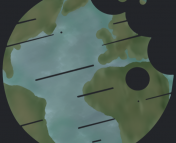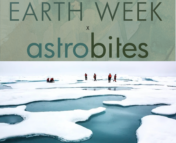This year, for Earth Week x Astrobites, the focus is on the intersection of Indigenous science and Western science. In particular, As students of nature, what can we learn from Indigenous science and teachings to support our stewardship of Earth in the climate crisis? For the second session of Earth Week x Astrobites, we had the opportunity to discuss this topic with Bridget Kimsey. A short summary of the discussion is given in this bite, but the link to the full discussion with Bridget can be found here:
Bridget Kimsey is of Lenape descent (a member of the federally recognized Delaware Tribe of Indians of Oklahoma and Kansas) and also of Irish descent. She has interest and experience in a diverse array of scientific fields as well as the application of Indigenous science and research and science. Bridget is currently completing a masters of science degree in space studies/astronomy and will begin her PhD in artificial intelligence this fall. At present, she is also a Solar System Ambassador for NASA/JPL.
Bridget offers a unique perspective, because as a child, she got to see the combination of two distinct lenses on data and layers of reality. From one point of view, her father was a scientist who worked on electron microscopes, in his lab at John Hopkins University, working within modern western scientific and academic systems. This exposure helped spark Bridget’s scientific curiosity, academic pursuits and desire to understand how the world works from the young age of three. On the other hand, being a Lenape Indian, she was raised as an American Indian. She had a close connection to her Delaware tribe through her family and its members. Bridget has found that this upbringing has shaped her perspective growing up by partly fuelling her passion and interest for her creative side, particularly in the deep layers and structure involved in story-telling. Growing up as a Native American also gave Bridget awareness of the reality of being of Earth and stars, that there is no separation between her and Earth, other species.
Bridget found that being female presented some obstacles for her to enter the academic path of physics and mathematics (which are quite male dominated fields), and she also felt encouraged to pursue a path that fulfilled a role more typical of women. Given that Bridget had also already identified passion in creative pursuits, she initially pursued study at the Baltimore School for the Arts. However, she has always found understanding science her refuge – she has a powerful passion and excitement for all science (both Indigenous and modern Western/Eastern). This led her to eventually change track towards science and complete an undergraduate degree in STEM (science, technology, engineering and mathematics) studies. Bridget acknowledges that her Indigenous tribe has been developing and teaching methodologies and approaches inside of scientific inquiry in multiple ways for 18,000 years. So for her, the scientific method of rigorously testing ideas and establishing facts to understand nature comes naturally as a passion to her, and she recognises that accumulation of knowledge and wisdom requires years of keen observation, application, and scientific study among the collective community in their ecosystem.
On the intersection of Indigenous science with modern Western/Eastern science, Bridget has found in her own work within the healthcare system, as an integrated healthcare practitioner, that while Indigenous science is utilized by herself at times, credit is not necessarily given where credit is due. In her own words ‘I don’t like that [it is] not being seen at the table and I think what is being seen at the table can only be understood and seen as Indigenous science.’ And that ‘people bring Indigenous knowledge. [But] It has to be somehow minimized or put down.’ Bridget believes that Indigenous science and modern Western/Eastern science can work together, but at present this isn’t happening. There is wisdom from which to draw inspiration, and in the context of climate change, this may be very relevant. Indigenous science takes an approach to nature that is less extractive than Western science; recognising that it is a fundamental fact of being alive that we are extension and always in discussion with all of nature, rather than viewing nature as resources for us to simply use up.
Edited by Olivia Cooper




